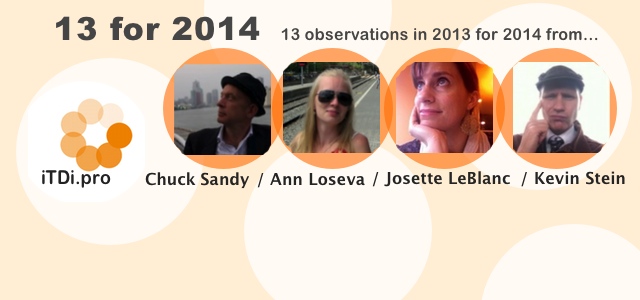12 ways my PLN (often unexpectedly) made my classroom a better place for learning (and teaching) + 1 look ahead
– Kevin Stein

This year has been a little busier than I would like. In many respects I feel like I took much more from the teaching community than I was able to give back. And is often the case when busy, I haven’t taken as much time as I should to say thank you. So I’m grateful to have a chance to share a collection of 12 ways my PLN made my school a better place to learn and teach in 2013.
1) I love Post-It notes. This might seem like a very small change, but it has been huge for my students. The fact that I don’t need to run to the board, that the post-in notes remain right there in front of the students, that they can be picked up, elaborated on, slapped into a student notebook and taken home, all of these things make all the difference. So thanks Carol Goodey (http://cgoodey.wordpress.com) for the original nudge towards post-it notes, and Larissa Albano (http://larissaslanguages.blogspot.it/2013/10/the-power-of-post-it-notes.html) for another example of why Post-It Notes are a crucial classroom tool.
2) Be a gentle observer. A few months ago I was wondering why, whenever I observe a class and a student seems unsure of a vocabulary word, the teacher invariably stops the flow of the lesson and insists that the student (or class in general) try and guess the meaning of the word from context. Why doesn’t the teacher just give the meaning and move on? I was kind of ranting about the situation over drinks with a more experienced teacher. He laughed and said, “Maybe they’re just teaching by the book because you’re in the room.” It hit me that being observed often comes with the feeling of wanting to do things the “right way.” Being an empathic and supportive observer means keeping this in mind, always.
3) Comprehensions question, not so bad. I wrote a series of posts over the course of the year in which I derided comprehension questions. I was, for the most part, very, very unforgiving and harsh. Members of the community were for the most part, much more forgiving of my unforgivingness. On Twitter, in e-mails, and face to face, teachers would ask (and so gently), “Don’t you think there might be a role for comprehension questions?” And because they kept asking, I kept thinking. Eventually, as I was teaching a class in September and thinking how useless the coursebook’s comprehension questions were, I remembered something John Fanselow (http://peacecorpsworldwide.org/teaching/) said: “If you don’t like the questions in the book, have the students make up their own.” So that’s what I did. And that’s what I’ve been doing ever since. Comprehension questions do serve a purpose, especially when students write them and ask them to each other to check their own comprehension.
4) Video as student tool. For the past year, I’ve been taking short videos of my classes to use as observation tools with my fellow teachers. Nina Septina and Tim Murphey, both iTDi-ers, suggested that I could take those same videos, give them to the students, and let the students use them as models to practice English outside of the classroom. Their suggestion was, I think, based on a paper they wrote together here (http://peerspectives.files.wordpress.com/2010/04/language-performance-videoing-for-home-viewing.pdf). And it allowed me to take a observation tool for teachers and turn it into a resource for student learning.
5) Moving isn’t just for children. As a high school teacher, it’s all too easy for me to fall in the trap that sitting at a desk and puzzling over difficult language is what learning is all about. So thanks to Sir Marco Brazil for your collection of videos (http://www.youtube.com/user/5254marco/videos), Malu Sciamarelli, and Barbara Sakamoto (amongst others) for reminding me that getting up, playing with actual objects, and physically feeling the wonder of learning isn’t something that diminishes as our learners get older.
6) Walk the mistake walk. I often give lip service to the idea that making mistakes is good, and that students should make mistakes. But what does that mean? And how can I do more than just give lip service? One of my favourite PLNers, Sophia Khan (http://languagelearningteaching.wordpress.com), started a blog this year and she had me thinking about mistakes. I realised that probably the best thing I can do is just own up to my own mistakes in class and show the students how I’m going to use that knowledge to make future classes, hopefully, a bit better. So this year I’ve said sorry a bit more often. And I like to think that’s helped my students see their own errors as a chance to improve.
7) Useful tech. This year I set aside some time for the students in the computer room. Not much, about an hour a week. Some of my favourite bloggers have kept up a steady stream of comments and reflections on tech they love to use in the classroom. So thanks to Sandy Millin (http://sandymillin.wordpress.com)and Chiew Pang (http://aclil2climb.blogspot.jp/p/useful-resources.html) and many others, for links and lesson plans about Quizlet (quizlet.com), Lyrics Training (http://www.lyricstraining.com), and Storybird (http://storybird.com) to name just a few of the tools that my students have loved enough in the classroom to take outside of the classroom and make language learning a larger part of their lives.
8) Pronunciation work has always been one aspect of language teaching that I felt could be saved for when there was more time. But in a classroom, there is never really “more time.” A series of blog posts on pronunciation by Alex Grevett (http://breathyvowel.wordpress.com) convinced me that students might be much more interested in pronunciation that I thought. So thank you Alex for convincing me to take the time I need, and the students want, to focus on pronunciation issues.
9) Tell ‘em what’s wrong. Cecilia Lemos, iTDi associate, blogger and teacher, gave a talk at IATEFL (http://iatefl.britishcouncil.org/2013/sessions/2013-04-09/oral-correction-reflections-recovering-recaster) this year in which she challenged the notion that clearly correcting students’ mistakes will somehow inhibit classroom learning. It was a great chance for me to rethink what error correction is all about. And when I asked my students, it turned out that they wanted, whenever possible, quick, clear and concrete error correction as well.
10) Go to Activities. At the end of the year, Anna Loseva (http://annloseva.wordpress.com/2013/11/16/the-flashmobelt-movement/) and Michael Griffin (http://eltrantsreviewsreflections.wordpress.com) came up with #FlashMobELT, a lino wall filled with classroom activities that take little to no preparation. (http://linoit.com/users/annaloseva/canvases/flashmobELT). Having 1 or 2 of these activities in reserve has given me a nice cushion to fall back on when things don’t exactly go as planned.
11) Other Ways to Collect Feedback. For much of the year, I found myself stuck in a student feedback rut. But thanks to posts on fostering student reflection by Alex Walsh (http://www.alienteachers.com/1/post/2013/05/promoting-student-reflections-failures-successes-and-lessons.html) and a host of other suggestions such as feedback boards, many of which can be found here on Anne Hendler’s blog (http://lizzieserene.wordpress.com/2013/12/19/collecting-and-using-learner-feedback-a-workshop/), I was able to make the giving and collecting of student feedback a much more enjoyable part of class.
12) Teaching is trust. When a class starts, and the students are sitting at a table, all of the theory and knowledge in the world isn’t going to do very much if your students don’t feel that you care about them. Every single time I read a blog post, every single time I perused the iTDi forums and interacted with teachers on FaceBook, I was reminded again and again, that here are a group of teachers who are, more than anything else, dedicated to their students. Dedicated to fostering their students’ potential, to making a safe place for learning. And knowing that I am part of this community, makes me a much better teacher than I used to be.
So this has been a year of much taking. These are just 12 of the ways the teachers I know and respect have made me a better educator. Which leaves me with 1 more something to bring this post to a nice round 13 for 13. And I would like to end by looking to next year. #13 is a promise to give something back. This year, more than anything else, I’ve learned that I am a member of a community which recognises the value of experience. We are a community which believe that all teachers have something important to say. So my goal for next year is to more actively help to create that kind of space and invite as many teachers as I can into it. Because 14 for 14, 15 for 15, and even 45 for 45 is well within our reach. Especially if we have a chance to hear the rich and nuanced voices of all the teachers dedicated to making learning possible.





